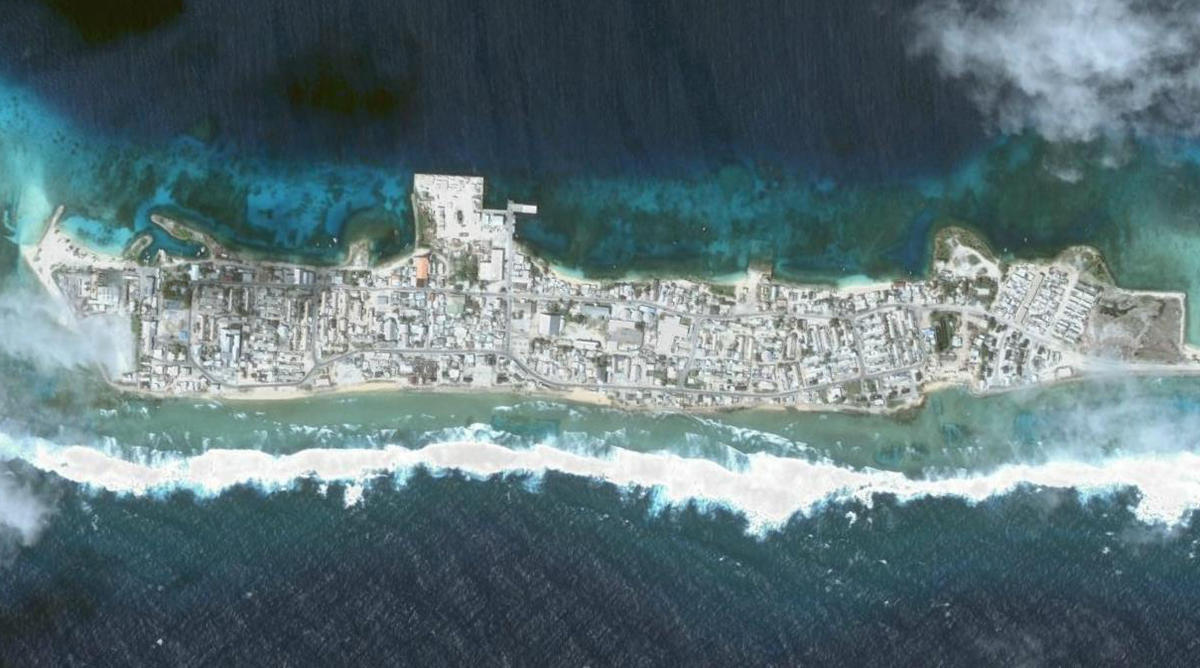Ebeye’s Challenge, Hawaiʻi’s Lessons
 Ebeye Island in the Kwajalein Atoll, Marshall Islands. Credit: NASA
Ebeye Island in the Kwajalein Atoll, Marshall Islands. Credit: NASAHawaii Public Radio (HPR) interviewed SOEST associate dean and geologist Chip Fletcher, who is also the vice-chair of the Honolulu Climate Change Commission, after his recent visit to the Third National Dialog on Climate Change in the Republic of the Marshall Islands. Fletcher delivered the keynote address during the conference held on Ebeye, an islet in the Kwajalein Atoll, Marshall Islands. The options the Marshallese community face could be considered in adaptation planning in Hawai‘i.
Below is an excerpt from the HPR story.
Kwajalein Atoll consists of a ring of reef islets around a large central lagoon. Several of those islets house U.S. military installations and most local residents who service those installations live on Ebeye.
Fletcher says Ebeye’s over 13 ,000 people live on one square mile of a low sand and gravel island that has an average elevation less than two meters above sea level.
“This is one of the most vulnerable populations in the country, if not the world.”
On Ebeye there are only 4-6 blocks between the lagoon and the ocean. Fletcher was there as the country considers its options against continual flooding and sea level rise: build walls, or elevate the land. World Bank officials were there assessing public opinion on a planned wall, six feet or more above street level.
The effect on culture and daily life would be drastic, Fletcher says, “You’d be living in this town, and if you look to the ocean, you’d see the back of a wall.”
The wall will cut air circulation, and destroy the view, but Fletcher points out that continual erosion has to be stopped, and repeated wave inundation must be mitigated especially with the threat of hurricanes.
As Ebeye islanders cope with frequent flooding, and infrastructure breakdowns, a crisis seems near. Still, Fletcher is wary of simple-sounding solutions.
“I have to admit that maybe the wall is a trap. Thinking that building this wall is a solution…it’s very simplistic thinking to a problem that’s extremely complex when you look at the socio-economic, the social justice, the cultural, the health elements of all this.
In 1956, the U.S. Atomic Energy Commission called the Marshall Islands “by far the most contaminated place in the world.” Overcrowded Ebeye has been called the “Slum of the Pacific,” and one major daily chore is finding clean water.
“So is the solution, instead, maybe new building codes?” Asks Fletcher. ”And if you were to implement new building codes, it would be an opportunity to give these folks real houses and real infrastructure.”
Fletcher is interested in leveraging climate mitigation to create better communities.
He says, “The takeaway for Hawai‘i is, Let’s think very comprehensively about our adaptation steps in the very earliest stages and the only way to do that is for everybody to be well informed.”
* * *
A global youth climate strike is set for May 24, Friday, with over 13 hundred cities around the world participating. Honolulu’s action will start at 4pm at the corner of Fort Street and Beretania, then proceed to the waterfront. More about the world wide efforts can be found at Fridays for Future and Climate Strike.
Listen to the interview on HPR.



